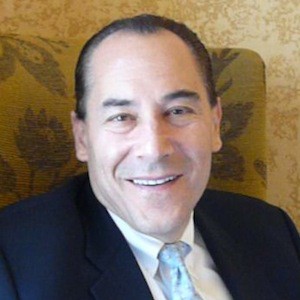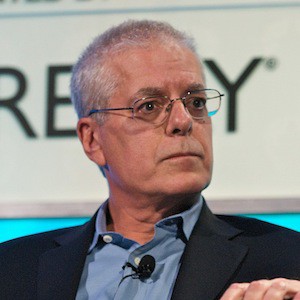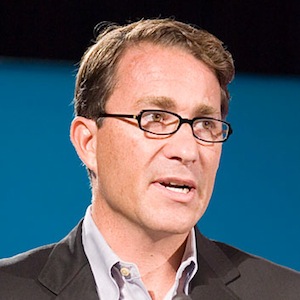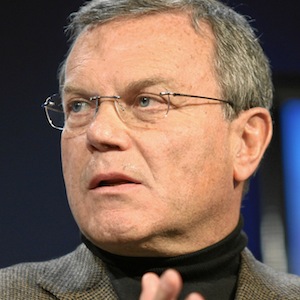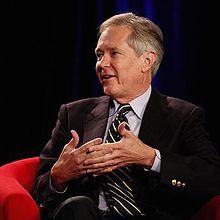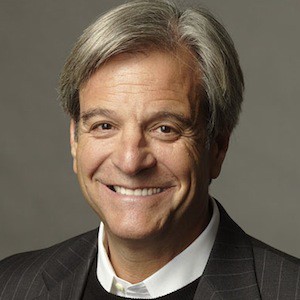Martin Nisenholtz: Here we are in the offices of keep.com with Scott Kurnit on March 14th. …You go back probably further than anyone that I know in consumer media.
Scott Kurnit: Who’s still alive?
Nisenholtz: Maybe, no. But to Qube, can you talk about why you went there? What was the attraction? What it was? Then we’ll work forward from there.
Kurnit: Qube was awesome. I was in Springfield, Massachusetts as the youngest program director in the PBS system. I was introduced to Qube by John Lack.
I went for an interview thinking I was interviewing for CBS Television and John was CBS Radio. I had never thought about being in radio. Whatever.
Several months later, I got a call to go out to Columbus, Ohio, for Qube, this interactive cable system. I was the fourth program director in a year and a half. This was Warner Cable at the time, 1979, inventing interactive TV, and it really worked.
It was 25,000 subscribers that had a box in their home that had five buttons on it and a message light. With those five buttons and a message light that responded every six seconds, you could do amazing things from game shows to George Bush coming out when he was running for president, “I will never be vice president,” that was one of those great lines.
And have the viewers control the programming and on game shows, win. Power Play was my favorite game show we did where you won points and then you could wager points using your message light to determine whether you were in the top 5 percent or 10 percent to get to a single winner against potentially 25,000 customers.
We had hoped back then, in ’79, that interactive TV was the future.
Paul Sagan: It was.
Kurnit: It was. It’s still not here yet, interestingly. Here we are 30 plus years later, and it still hasn’t arrived. It’s still not nearly as sophisticated as it was back then. It worked technically. People liked it. It went down because Atari, interestingly, sister division at Warner, went from making a billion one year to losing a billion the next year, and everything that wasn’t glued down was shut down. That was Qube. At that point, it was a JV with American Express, which got into it because…
Nisenholtz: You were talking about QUBE having…
Kurnit: QUBE was this incredible experiment, experimental television for a lot of reasons. It was, “Hey, should pay per view exist or should it be subscription?” We made the mistake. We actually went pay per view while HBO went subscription. Subscription’s a better idea. A lot less friction than making a purchase decision for each program. It was a laboratory where MTV and Nickelodeon coincidentally got created. It’s like, “Hey, we’re in Columbus. We have this test market. Let’s bring…”And we had 30 channels, which was another part of QUBE. It wasn’t just interactive. Cable was 12 channels back then. How do you fill 30 channels?
We picked up a bunch of cartoons from Europe. We picked up videos from Europe that were playing in music stores that nobody in the US even knew what videos were. It was a great laboratory for television, but it was created for the interactive part, which was really fascinating.
Nisenholtz: Was there anything that resembled news at the interactive part or was it really…
Kurnit: We did three original shows a day out of studios. It was a surprisingly interesting operation, probably two to three hours of original programming a day. One of them was called “Columbus Alive,” which you would say is news or entertainment, kind of like the Today Show at night. We experimented with every format under the sun because it was a laboratory. What was interesting was, and I think interactive TV probably would have happened had we franchised QUBE to the rest of the industry. Instead, we made the decision to use it to win franchises.
At the time, we won Dallas, Houston, Pittsburgh, St. Louis, Chicago because that’s where I traveled every week once we started to turn those on. And then Cox competed with us with Index and Time, Inc. competed with cable, with the ATC division.
Everyone had to compete with interactive TV. They had to say, it’s either bad or you don’t want it; you want conventional cable, because they didn’t have it.
In hindsight, I think, I really do, if we had actually franchised the system, the technology and the programming, we would have had interactive TV long before the Internet, because in a lot of ways, this was a precursor.
Nisenholtz: You jump forward and back too much, because there’s a lot to cover here. But there were a bunch of experiments that were interesting that didn’t quite work, like this one for a business model the source, the VideoText stuff that was done … by newspapers. Then, when the real change happened, the way that the user thinks of the web as interactive TV now with broadband, etc., those same companies had a hell of a hard time figuring out what to do.
In some ways, and someone suggested to us, they had such bad experiences, they plowed so much money into those things, they didn’t take off. They learned bad lessons. Do you think that’s a theme that [inaudible 00:03:07] today?
Kurnit: Yeah, there’s no question. It’s interesting; I had a conversation with Jerry Levin somewhere along the way when Time Warner did the full service network in Florida. Then, it was a fascinating lesson for me that corporations have no history. I said to him, you’re doing full service network and you guys spent 40 million dollars, which was a lot of money. Still is a lot of money, but it was a lot of money, obviously, in 1978, ’79.I happened to have, and I still do, 3 linear feet of memos. I said, Jerry, it’s yours. I have it because otherwise, it would have ended up in a dumpster, but the stuff that’s in there is just off the charts amazing.
I just pulled out my January 1979 monthly report recently that went back to corporate. It’s like six pages of unbelievable stuff we were doing. I said, “You’re doing the FSN in Florida, you own this.” He says, “Well, we don’t need it. We’re doing it again.”
Nisenholtz: I can tell you, having been there, it was all the way or it was nothing on it.
Kurnit: Exactly.
Nisenholtz: All over and added not quite 10X to the total cost.
Kurnit: Right. Just reading, I think that reading through my loose leafs of memos would have said, we probably shouldn’t do this, or there would have been certain shows you would have said, that’s been tried, they didn’t work. Or whatever. It’s fascinating to me, one, that corporations don’t have their own history, because it’s in the people who actually walk out the door. The other thing is, and I learned this at Prodigy, is that when someone would say, “Hey, we ought to do X Y Z, because so and so,” I was the new guy at Prodigy.
It’s like, “Well, we tried that. It didn’t work.” I would say the biggest one for me was when I went to the marketing guys and said…”I met this Steve Case guy. He seems really smart to me. He’s like carpet bombing the world with discs.” They go, “We tried that. Didn’t work.”
I would say that was probably the biggest error in my own career, was while Case, this guy whom I think is twice as smart as I am, and experienced in the early Internet pre Internet. I said to my guys, “We should do what he does,” and then we did it.
Now, Prodigy had two discs, he had one. Prodigy was a horrible service, AOL was an awesome service. So there are other things that get in the way.
I specifically remember grocery deliveries, so Peapod, which didn’t work either, but it comes along. The guys at Prodigy go, “Doesn’t work.” In some ways, Web van, I guess it was. In some ways, they’re right, but on the other hand, Fresh Direct’s doing quite nicely right now.
This stuff tends to have its time. If a company has done it before, they are just culturally unable to do it again. There’s no one who’s going to stand up and say, “We failed at that, but we should try it again.”
No one is going to ever step up, so I think that interestingly, early innovators who fail at things will never do…I think just culturally, they can’t do it. The people who make up companies go “I’m not doing that.”
In some ways, it’s interesting that full service network happened on the heels of Qube two decades early, but maybe there was enough time in there where they didn’t even know.
Nisenholtz: One decade earlier.
Kurnit: Was it one decade earlier? It felt like a lifetime.
Nisenholtz: But they both failed. They both technically worked and failed as businesses.
Kurnit: Yeah, but it’s interesting. Qube failed because of Atari, not because of Qube, which was what was really interesting. Interactive TV that engaged people as we were, we had show after show that was really interesting. My favorite show I’ve ever produced in my life probably was “Your Call Football.” It was a single football game in Columbus, where the viewers called the plays.
The game took four hours. The stadium got hit by lightning as a coincidence. I’d say that could never happen except in the last Super Bowl where the power went out, but the power went out.
So for our little semi pro event, we got something, believe it or not, like a 60 rating across our 25,000 subscribers. It was huge because it was really interesting.
When you put the power of calling the plays in the viewers’ hands, they did crazy things. It’s fourth and one and they throw a bomb. A coach wouldn’t do that, but the viewers did.
Nisenholtz: So it taught a lot of lessons about interactivity, but not online. It was not a good experience.
Kurnit: No. What’s interesting is we did four at Columbus in 1979. Four CompuServe subscribers got their CompuServe service over the Warner Qube cable plant. Kind of interesting, way early precursor to what would’ve become @Home and then would’ve then become all Internet delivery, or so much Internet delivery over cable.
Sagan: Well, in Columbus, it became Roadrunner.
Kurnit: Yes. [inaudible 00:07:50] in Columbus was four cable systems at the time. I don’t know what it is now. It’s probably…
Sagan: Fast forward to the ’90s and it was one, and it was the first…It was not the first cable modem market, which was Elmira, New York, but it was the first branded Roadrunner market.
Kurnit: Instant. Interesting.
Nisenholtz: Now they pull the plug on QUBE and what happens to you at that point?
Kurnit: To me?
Nisenholtz: Yeah.
Kurnit: Before we pulled the plug, I got brought back to New York. I’m in Columbus. QUBE’s the only system. We used it to win franchises. I was 25. I actually, scared to death, was in front of the Dallas City Council as one of the three presenters because QUBE was so important. We replicated QUBE’s everywhere successfully. We created the QUBE network. We did shows where all seven QUBE markets got the same shows delivered via satellite, interactive, connected together.
We took it to the next level, which is why it would’ve been fascinating to say to the industry, “You know what? Everybody join in,” and we would’ve had networked, interactive television long time ago.
What happened was the Atari situation. Drew Lewis, former Secretary of Transportation, came in to Warner Cable. Just before he came to Warner Cable, he fired the air traffic controller, so this was a guy who took no prisoners.
He then brought in McKinsey, cut half the corporate staff, and reduced expenses so that anything that wasn’t profitable at that time, anything that was developmental, was killed. That was the end of QUBE.
Nisenholtz: Where did you end up?
Kurnit: Interestingly, the part of interactive TV that we kept was pay per view. Pay per view used the cable technology of knowing what people were watching every six seconds to say, “You’re watching a show. We’re going to bill you $4.95.” We networked pay per view, which was a business, across each of our cable systems. It then became clear, since we were doing it in six or seven systems, that if we had another three or four, it was worth putting this stuff on satellite.
So I morphed over, with my team, to Showtime. Keeping all my Warner seniority, interestingly, going to the JV of Warner and Viacom. At the time “Viacom.” Redstone changed the pronunciation when he bought it.
We did networked pay per view. We launched viewer’s choice in ’83. That continues today. I’m proud that that company, which then merged with request and is now in demand, is the pay per view infrastructure for most of the cable industry.
Nisenholtz: Did you morph to what we would think of as online, versus interactive TV, after that? Proprietary?
Kurnit: Yes. I had interactive in my blood. We did come up with the first pay per view ordering system. We, with AT&T, had the first commercial application for ANI, automatic number identification. You could literally call a phone number, we read your number, we knew it was you, we could add it to your bill. Pretty interesting tech, pretty early. Then I got called by a recruiter to go to Prodigy. Which, I believe at the time, was the world’s worst company. I think it was truly the world’s worst company. The week I went to Prodigy, my boss, Tony Cox, threw Fortune Magazine across the table at me. It had the three dinosaurs of American business on the cover. I say that for a good reason.
It was General Motors and Prodigy’s two parents, Sears and IBM. The three dinosaurs of American business. He said, “How could you possibly go there?” I said, “Because it’s the future. It’s new. It’s different. It’s exciting.” I went to Prodigy. Two months later I met Steve Case. Or a month later.
He said, “How could you possibly go there?” I said, “Because you didn’t call me.” AOL was the better business, by far. Much more interesting.
Nisenholtz: What year was this?
Kurnit: It was pre web. Yeah. I went to Prodigy pre web. Hopefully the technology exists for you to edit that out, not remembering. Prodigy was not a fun experience. It was a company created out of IBM and Sears, which meant, culturally, it had the personality of its parents, competing against a scrappy startup run by Steve Case. That was an unfair competition.
Sagan: What did you learn about interactivity, as we transition? Because we want to get to the web and the Internet. That was sort of a bridge, I guess, between the interactive TV and…
Nisenholtz: We’ve got to get to MCI, first.
Sagan: Yeah. But that was part of the evolution.
Kurnit: MCI came after Prodigy.
Sagan: Yeah. What you learned about Prodigy about the power of interactivity and what it would do to business models, news and otherwise. Then move to the MCI piece and fully to the web.
Kurnit: Prodigy was not a great system. It was run on very early stuff. It was run on NAPLPS, which was this archaic system of painting images on the screen. It was very cartoonish.
Nisenholtz: North American Presentation Level Protocol System.
Kurnit: Good for you, Martin Nisenholtz. You and like five other people know what NAPLPS actually is. [laughs] Meanwhile, interestingly… I’m going to talk about competition, because AOL was built on top of Windows. Because of IBM losing the OS2 battle to Windows, the whole concept of Windows at Prodigy was like, “We don’t do that.” Prodigy was built on DOS. Disc Operating System. AOL’s built on Windows. Elegant, back then. That was an interesting thing. But the easy learning’s of interactivity, which we see today, is that this stuff’s really engaging. We learned that content where you could comment, big deal. Content where you could easily get whatever you wanted from a big corpus, really interesting.
Even advertising, which Prodigy had and AOL did not, actually worked. People would go through the add queue of probably 150 ads. They really were banner ads. They ran at the bottom of the screen. They were not annoying. They were viable. Good lessons there. The big lesson has to do with pricing. Prodigy, because of its infrastructure, which had Akamai qualities.
Prodigy was a caching network that was able to cache contents in nodes all over the country. It had a significant benefit over AOL on content distribution and had parity with AOL in communications. Because there was no caching, obviously, in chat and message boards. So Prodigy’s pricing was geared towards the content. That benefit of network was maybe their Achille’s heel.
Prodigy gave you unlimited use of content in two hours use of communication. AOL gave you five hours use of communications, which is all anybody wanted to do. That was an interesting lesson.
The online systems, back then, were so efficient for chat and message boards. The other thing was, Prodigy, because it’s run by IBM and Sears, literally read every post on message boards before they went live.
While AOL just said, “Put it live. We’ll worry about it later.” So there was that issue coming up again. It’s not just that corporations are slow to move because maybe they did it already, they’re slow to move because of their decision making. They’re slow to move because they’re conservative. While AOL didn’t mind someone saying, “I’m going to cut my Sears credit card in half.”
A company half owned by Sears would not tolerate someone saying, “I hate Sears.” We’ve learned over time that anything goes. You publish fast, you worry later, etc. I think The New York Times still previews messages before they go live.
Nisenholtz: In some areas.
Kurnit: Which makes the message boards better. But it also slows you down against the Twitters and Instagrams.
Nisenholtz: Talk about news in any form. Financial, sports, headlines, stuff that happened, either at Prodigy or that you observed at AOL.
Kurnit: We, at Prodigy, had four divisions. One was news, news and information. We had financial services. We had stock quotes. You could buy stock on Prodigy. It was both information and transactions. We took in all the wire feeds. We actually did have a bit of a newsroom.
Sagan: You had wires because you were a closed system? Was it the AP and Reuters would sell to you the way that they didn’t at first?
Kurnit: Correct, they would have viewed us as a newspaper. We were a closed subscription system. Fascinating thing about Prodigy that I learned, maybe even afterwards Prodigy was meant to be a free service. The only reason Prodigy had a billing system, this is really interesting, was that the original business model assumed…IBM, Sears, and CBS was originally Trintex. CBS got out early, to the point where Mel Karmizan, when we talked about him buying About.com, pre my IPO of About, I said, “You know you owned a piece of an online service once.” This was where corporations have no memory, so Mel is CEO of CBS. He goes, “We did?” I go, “Yeah, like you owned a third of it.” But they got out, and it was IBM and Sears.
But the original model was that they would…that Sears, using this interactive system, would sell two things a month, so we need a way to track people.
A billing system was a way to track people even though were not billing. Well the reality was, they sold one thing every few years, so the model was off by 24X, shit happens.
Nisenholtz: You were up there in what year?
Kurnit: I left to run MCI’s Internet business in ’95.
Nisenholtz: So the webs come along, it’s starting to blow up to close the walled garden model, and be open to the web.
Sagan: But isn’t the MCI business still a walled garden? [cross talk]
Kurnit: Well before that’s fascinating, one of the things we did at Prodigy, which if you talk to…
Sagan: MCI and News Corp, right?
Kurnit: It was MCI News Corp, but before we get there, there’s an interesting sidebar, and that is we put web browser in Prodigy six months before AOL. Ted Leonsis would actually wax poetic on this, because it like shocks them and freaked them out that Prodigy came along and did this. It’s interesting; it was one of those kind of basement projects. We’d gone off to see Netscape at the time, which was all of the maybe 10 people, and it was kind of intriguing. About two weeks later, one of our guys said, “Hey, take a look at what I built.” He built a web browser in like two weeks, and we put it live in Prodigy. What was so interesting about the web browser in Prodigy, Prodigy’s a closed service, and the web browser is completely open. In the stroke of a minute we flipped Prodigy’ business model for better or worse on its head, and if you think about it, as a closed model…and one of the reasons I was brought in was to bring the cable industry to Prodigy.
We had just about every cable network had a place on Prodigy. Now interestingly, we own the distribution system, so who pays for lunch is kind of my example of business model. You go talk to a cable network, they want on your new interactive system, they pay for lunch. You then open up the Internet where anybody who creates a website can get on your service, I pay for lunch.
That was a transition that was very scary for Prodigy. When we went to a board meeting and said, “The web is it, we should abandon our NALPS system, because it’s a generation behind AOL, and we should trump AOL by going all web,” it’s like, “Wait a second, that’s a total flip of business model also.” The answer is, “Yes it is, but that’s where it’s going. Kids in garages are going to make stuff that blow us away.”
That was not well accepted by the Board of Directors to say the least. About two weeks later I got a call by a headhunter to go run MCI’s Internet business, it’s like, “Sign me up.” I went to run MCI’s Internet business, I was hired really quickly, it was a week from start to finish and in hindsight I now know, and that’s why it was so fast is they needed someone on their side of the table for what was about to be at JV with News Corp.
It was not at JV when I joined, so I joined Prodigy to run its Internet business…
Nisenholtz: No, MCI.
Kurnit: I’m sorry, I joined MCI to run their Internet business, and two or three weeks later my pager goes off, and it’s like, “We’re doing this to billion dollar deal with News Corp, you’re going to run this JV.” I pleaded with them not to do it, interestingly. I’d been in several JVs in my life, they don’t work. They work on day one, but…at the closing dinner, everything’s great appetizers and by desert they’re already unraveling before we even go forward. In my interview process, the guys at MCI said, “What you think of Delphi?” I go, “I don’t, there’s anything there.”
Nisenholtz: Dan Bruns’ Company.
Kurnit: Dan…Exactly. Rupert had bought…News Corp. had bought Delphi, and then they ask a question about…then we talked about JVs, and I said, “Terrible idea,” so Delphi, terrible idea. JV in general, bad idea, and then two weeks later after I get there, they go, “Oh, by the way, Delphi is the cornerstone of your access product, and News Corp.’s your partner.” Its like, “If there was a gun…” I don’t know. [laughs]
Nisenholtz: Didn’t News Corp. have an editor at that point; it was I think a woman…
Kurnit: Well Anthea Disney.
Nisenholtz: Right.
Kurnit: She and I became very good friends. She is awesome. We were set up to want to kill each other, so structurally there were a bunch of issues. It was a fascinating issue, because the original construct was Anthea, who I think the world of, would be in charge of editorial and report to the board, and I’d be the publisher, and I’d report to the board. I said, “No, no, no, no, no this is a TV station, this is not a magazine.” I won that battle, which was interesting, but it made for early complexity which she and I then figured out. Her editorial team built an awesome product called iGuide, building on top of the Delphi the…
Nisenholtz: It was not an Internet product, it’s very important, or was it?
Kurnit: Oh no, it was a wide open Internet product.
Kurnit: Oh no, no, no, so…
Sagan: This is not…so we’ve transitioned from the proprietary service of Prodigy, now you’re working on the web.
Kurnit: Well interestingly, the proprietary service of Prodigy added a web browser, which opened up Prodigy, whether they like it or not…
Sagan: Right, right, right, but they didn’t want to do that.
Kurnit: Still a subscription service. They were so keen to do that. Those of us who were working it, and seeing where it was going whether we like it or not said, “We have to do that, and we can take advantage of that.” McKinsey had bought, by the way, been in at Prodigy for some time, and frankly I guess I can admit now that About.com, which I ended up doing two companies later was an outgrowth of what I pitched for Prodigy to do, interestingly. Towers and pebbles, channels and micro sites, which is what About.com became. At MCI it was all open web. Vint Cerf was there, Vint actually on paper reported to me, but you don’t take the father of the web and constrain him much, it’s like, “Vint, whatever you wanted to (do) is OK.”
Sagan: At this point open web content was in the service of driving access subscribers effectively?
Kurnit: Yes, and what MCI meant to do with the web is, guys like Vint were there who obviously saw the web for anybody created it, and MCI looked at it and said, “Well we have all of these customers we do business with, these stores…” The first thing that they had created, even before I got there, or were starting to create was a shopping mall of all the stores. “We’ll build them for you, you’ll sell things, will have all these stores, we’ll end up being first mover, we will be the place for shopping,” and it was…
I forget what we actually called it, but it was part of Internet MCI, and it was a mall, and it was quite good at that time. MCI really did, I think, early on have a good…
Sagan: I remember when you came in pitched that.
Kurnit: To you. [laughs]
Sagan: Yeah, that timing, as an alternate partner, and it was all about shopping.
Kurnit: Right, and that’s because MCI had customers with phone relationships, and MCI’s pitched to Murdoch was, “We have 23 million customers, you have content, the Internet is a blend of commerce, content, and communications. We bring the business customers for stores, we bring the residential customers who will pay us maybe the 9.95, 11.95 a month for service. You have content. We can create AOL on the Internet.”
We did a business plan, it was $500 million expense over a period of four or five years to create this, Murdoch in about 10 minutes went, “This is good, do this, go.” MCI completely freaked out, they said, “That’s a nickel a share.
“Rupert said, “I don’t understand?” It was a nickel in earnings per share, and MCI, if you now look backwards was kind of in sale mode, they ultimately sold to WorldCom, so a nickel a share to them was catastrophic.
To Rupert, who didn’t really care about his stock price on any given day it’s like, “Yeah, I get that it takes $500 million to go build the new AOL on the Internet,” and was prepared to do it. But that joint venture unraveled pretty quickly.
Part of it was that IGuide was a good product; the access business that we built on top of Delphi was not so good. Frankly, all the early access businesses were a little flaky. As we handed disks out to all the MCI executives, some of them couldn’t make it work.
They had conflicts with Internet MCI that they already had on their machines, so even though the access product, I would say, was probably as good as anything that was out there, MCI looked at it and said, “This things not perfect, and if we’re going to put this in the hands of our customers, we’re going to ruin our core business.”
Sagan: Well so, if we come down to the innovators dilemma where, “You are what you are,” theirs was, “We’re a nailed up phone company, we got more nines in our service level…”
Kurnit: Yeah.
Sagan: “So something that might not work, or the customer has a flaky PC experience, they’re going to look at it with a phone filter, and this is a disaster.”
Kurnit: You know you got that right, so MCI said, “We can’t do this, we just can’t do it.” Then pretty much in the dark of night, it was a Super Bowl Sunday, I was called to Washington…about a year into the project. Interestingly that JV actually never got formed. The outside world, who was convinced that it was, but I actually got my paycheck from MCI, Anthea got her paycheck from News Corp. There was a Board of Directors of three from each of the parent companies, but the JV actually never existed legally as a JV.
Because they just couldn’t get it together to bring the two together, and then what happened was interestingly on a Super Bowl Sunday, I got called to Washington, told by my MCI brethren that, “Tomorrow at noon there’s a press conference with Bill Gates and Bert Roberts, and were pulling out of the News Corp.
JV that you’re running, and were going to throw in with Microsoft, and we want you to come back and we went to run that, which will be MCI’s customers running Windows 95 or Internet access.”
It was a fascinating moment in my career, because I said to the guys, I said, “If you have Windows 95, you get…” what I guess was called MSN in at the time, Microsoft network, or whatever it was, “…and you need it to run it, so we actually can’t sell any units.
You’re sending our chairman in to talk with Gates tomorrow in front of the press for a product that no one can use, that no one can have.” They did that press conference, the ultimately sold zero copies of that product, zero, because you couldn’t sell it.
So basically we blew up the would be JV of 800 people that we had between the companies. We were running a games division, we ran Kezmi which was games, MCI mail…
Sagan: This is the News Corp?
Kurnit: The News Corp/MCI JV had a lot of stuff in it, it was like all the ragtag y, interactive stuff of the two parents in the JV. And it was 800 people, and it’s like…I think it was Valentine’s Day, where it’s like the big company meeting, “Guys, were not could do this anymore,” kind of like Ameritech. [laughs]
Sagan: Was that the same year between Super Bowl and Valentine’s Day?
Kurnit: Oh, it was Super Bowl and then…Yeah, so it’s two weeks later we blew up the business. Yeah we blew up the business right on the heels of the Microsoft press conference, yeah.
Sagan: And then that went nowhere, technically?
Kurnit: Technically it was impossible deal, but MCI was always intrigued about having a relationship with Microsoft.
Sagan: Talk about the user experience around News Meta 12 content, then. When you’re on the open web in creating [inaudible 00:30:13] . What did people do, and how did it change their habits? Did you see any of that?
Kurnit: IGuide was a guide to the Internet. We had editor’s that were combing for good websites back then. There weren’t that many of them, so it was actually possible to do by hand.
Sagan: A little bit of Yahoo copy?
Kurnit: Very much. Very much like a Yahoo. A little too heavy. The Pathfinder problem of being too beautiful, but not delivering in speed, so when Yahoo, because their pages loaded in two, to three seconds, versus Pathfinder at 30, and our stuff at 18 seconds a page, made a big difference. Anthea’s background as a news person, as an editor of a range of magazines, created, I thought, a really interesting news product, and a newsroom. Coupled with the wires, and other sources that were out there. I can’t recall well enough, I guess it didn’t really change news consumption, back then.
Our product was too thin. The likes of magazines, and television were still strong. We were not a dominant news source by any means back then. We were not a threat to conventional media, yet.
Sagan: No, but you touched on one of those themes that keeps coming up, which is the, “You either are what you are, or you compete with what you think you are.” You have a bunch of, effectively, magazine companies, or magazines types, or print types looking at each other, and not understanding that, somebody who doesn’t know those rules, and is doing something else, like Yahoo, which was basically, go back, that page had a couple of boxes, a Visa logo, and text, and was just cleaning up audience interaction.
Where these other things, which were beautiful, but not very useful.
Kurnit: Well, they were beautiful. I always used to say to people that, “The reason Pathfinder was so thick, is that you printed the pages to show Jerry Levin what it looked like.” “Because he probably wouldn’t use it on a computer back then, you can tell me later.” I was an advocate for simple, fast, versus beautiful, slow. I think that continues as we see things like Reddit, and Craigslist today. Simple, fast trumps beautiful. We also had the corporate problem that we had to serve the parents.
Sagan: That’s the same point, right?
Nisenholtz: As Prodigy too. It seems to me, whether it’s Steve Case, and Prodigy, or Jerry Yang in MCI, it’s very difficult for people who get up in the morning to work for a big companies to compete, with people who don’t. Who get up in the morning with a gun to their head, across the entire entrepreneurial spectrum? It’s just very difficult.
Kurnit: The question is. Are you doing it for the consumer, or are you doing it for some board of directors or for some sister division?
Sagan: … We can go then, post Microsoft, to all web stuff. What came after the Microsoft thing that blew up?
Nisenholtz: I had asked a question of, whether you think there was any hope for large corporate parents like the Prodigy, or MCI businesses to compete with AOL, and Yahoo respectively? In other words, I’m asking a cultural issue, Kurnit. As we go further along.
Kurnit: As we look at the future.
Nisenholtz: Yeah. The history of the news business too.
Kurnit: I think in theory yes, I think in practice it’s really hard. Having been in a bunch of JV’s, one of the things I actually tried to do was say to both MCI, and News corp. “Either of you guys could fire me.” “Takes two of you, to get the new guy.” “But I don’t want to be here because, I’m MCI’s guy, and they don’t have the right.” I saw that at Prodigy. The guy who was my boss, should have been let go, but he was CEO’s guy, and it was CEO’s turn. To me, I looked at that, and said, “Oh my god.” “That’s crazy.” Because the CEO is obviously so critical.
I put this forward, and they said no to it. I said, “Guys, this puts me at risk.” I don’t know why they said no to it. I actually wrote 10 points as to why it was a good idea. That I’d be on eggshells having to serve the mutual needs, or one guys going to say, “Out.” We’ve seen it. The start ups trump the established guys over, and over again.
I think it’s possible. One of my dreams when I sold About.com to Primedia was being able to take the About culture, and I’m a culture freak, and lay it on this traditional company. I was well aware that 50 percent of the people would reject the culture that I wanted.
It happened in the very first meeting, interestingly. At my company the word employee is banned, and the word consensus is banned. I walk into my first big group meeting at Primedia, and both of those words are used. You pay 20 bucks to the party fund here, at Keep, or About if you use either of those words.
The big company thinks that consensus is a good thing, even though it completely slows you down. I have other issues of the word employee, in terms of indentured servant, and things like that.
I think it’s possible, but I think that it’s only possible, and for the future, those of us who have been in those environments, who then go to start up. I think I could make a big difference, at a big company. Half the people would want to kill me, but I’d want to kill them too.
I did learn at places, Prodigy is an example, where ingrained culture was a problem, and so was Primedia. I do believe that half the people, whether it’s Time Inc, or New York Times, or whatever, want to take the helm, want to move into the future, are willing to take the risks, so it is possible.
Maybe there is a generation of us, who have gone corporate, then start up, and can go back to corporate, and make something happen.
Nisenholtz: Let’s talk about, About now. You left MCI. Did you start About right after that?
Kurnit: Pretty much. I consulted for Open Text, the Canadian search engine company. Which was Yahoo’s original search engine, and they said, “Hey, Yahoo just went public for 700 million dollars.” “They pay us a whopping million and a half dollar fee, which they’re actually not paying us, because they think we’re a commodity.” “What would you like to do?” I wrote them the two page memo. Which had been milling in my head from Prodigy, then at MCI where I wanted to do it, and they said, “Great, we’ll fund that”, and got into business pretty quickly.
Nisenholtz: The principles were based on your learning about how users wanted to contribute?
Kurnit: Really, two things. One is, how do you create something that’s really big? Very wide? That uses the power of the Internet for both distribution, and production? So is using all the power of the Internet to create something new. At the time most people thought it was not a very good idea. It’s interesting that 16 years later it’s alive, after five owners, and six CEO’s, because of its distributed nature. At the beginning it’s, “Can we make a site that’s run by one person?”, because as soon as you add more than one person, you get into all kinds of friction, and politics, “That can then network with others, both in terms of production, and distribution, that creates something that has an ever growing scale?”
I believed that, from what we wanted to do at Prodigy. I knew that there is passion out there in the world from the Prodigy experience, originally, that’s untapped. Where people don’t have the chance. Whereas, a Time Inc, or New York Times it’s like infrastructure, and distribution, and gate keeping, that the Internet was just much more flexible, and that we could take advantage of it.
Interestingly at the time, we got most compared to Geo cities. We were very different businesses. It actually infuriated me, even though Geo cities ended up being worth twice as much as us. There are some lessons there. Although they’re gone, and About is still around.
That was user generated. Build a container the users generate, and fill it. That’s what Twitter, and Tumbler, and Facebook, and Pintrest are. That’s a great model, that’s what Keep.com is, for shopping.
With About, we were much more controlling than that. We found people, we recruited them, we trained them, we supervised them, but just short of employees.
They were independent contractors who continue to be, which is an important part of the model, so that people had the [sense] that it was theirs, and that they had a passion for it, whether it was composite materials, or parenting.
It allowed us to have 750 verticals run by people with tremendous passion, and capability without having them all in one place, which is a big deal. LookSmart was a big competitor at the time. They put everyone under one roof and that model didn’t work.
Our model of distributed workforce has lots going for it. Very different than the current Yahoo was the mere issue of distributed. In this case the distributed workforce is probably one of the half dozen reasons that About exists today, while so many other businesses don’t.
CEO turnover, or selling the company, these people are in Argentina, and Switzerland, they never saw any of that. I think that not seeing the sausage being made
At corporate is actually beneficial to having been around. Use the power of the Internet, and still does, on all parts. Production and distribution.
Nisenholtz: I think that’s a very interesting point about the production, and distribution. I think the news industry recognized very early on, the power of distribution. The processes that go into quality news have to do with processes that, at least in some folk’s opinion, kind of transcend the changes in production technology. Part of the question is, can you get a level of quality out of a new production technology, versus an existing set of processes? As an example, About.com has one person, it’s a published first model, stuff is quite good, but a lot of times people make errors.
It would be great if you could comment on that, because from About, came blogging, and from blogging came many other things, that presumed to compete with traditional news processes.
Kurnit: It’s always fascinated me. About’s very efficient, but the content is B+. The New York Times is pretty inefficient, but the content is A+. The interesting thing, About is a published first model, so it’s kind of like, “Ask for forgiveness, fix it along the way, train the people, so that they don’t need to be edited.” Whereas, at the traditional companies, you write an article, and then two, or three editors look at it.
I just heard an interesting story at Time Inc, where someone has to actually submit her Instagram pictures, so she’s in her closet; she sees something interesting, she then has to submit it to the social media person, which means it takes two days, for her Instagram picture to go live. That’s Time Inc. Whereas; a start up [snaps fingers] would go live.
Here’s the trade off. How much better is that? Because it took two days, and it found itself into a queue through a corporate entity, that puts it live. They have to lose. Are they 10 percent better? They’re not 90 percent better, so on the classic 80/20 rule, Time Inc, New York Times, this stuff’s better, but it’s not enough better, to justify the cost, and time. Whether we like it, or not.
Nisenholtz: It seems to me that played out in encyclopedia. Microsoft Encarta replaced Britannica, and Wikipedia, which is kind of an About like model, in a way, replaced Encarta.
Kurnit: Correct. The interesting thing is, Encarta is more accurate. I always have that little five percent fear when I’m reading Wikipedia, because I see my own posting, which is 90 percent right, so we all have that feeling. I don’t think we put the genie back in the bottle. It’s interesting; along the way I think I own curated Wikipedia.com. You probably told me that’s a bad idea. If you can blend, if you can take something that’s crowd sourced, and give it another editorial layer, to just fix that 10 percent, that’s interesting to me. It’s not as efficient, but…You’re smiling…
Nisenholtz: I don’t think you ever told me… [laughs]
Kurnit: Of all of my bad ideas, you hadn’t heard that one?
Nisenholtz: No. [laughing]
Kurnit: If you take a look at the URL’s I own, you’ll see there’s lots of curation; I’m a big believer of curation. Which is, in some ways, in conflict with the craft. That’s interesting. GeoCities was worth twice what we were worth. We worth a billion seven at About, pretty good. GeoCities sold to Yahoo for four billion dollars. They had a cheaper model, and it was like, “Anything goes.” A true crowd source top to bottom. Mine was somewhere in between, probably, GeoCities, and the New York Times. I think we’re going to have to figure this out a little bit.
I do think that a slightly better curation on Wikipedia would make a better product. It would slow it down a little bit. It’s fascinating, because if we look at Wikia, which is the commercial version of Wikipedia, it’s not as good as Wikipedia.
Nisenholtz: Not even close.
Sagan: [inaudible 00:48:44] vessel, and fill it up more. There are a lot of those, but they haven’t necessarily endured. GeoCities was one, followed by MySpace…
Nisenholtz: Tripod.
Kurnit: Tripod, MySpace, et cetera. About, the curation has endured. Maybe it was not as popular, or valuable in a moment in time, but it’s endured. In some ways you could say, Wikipedia is semi curated. It’s curated by editors, et cetera. Over time it’s, maybe this is controversial, there’s some that would say it’s now more accurate than the curated encyclopedia’s. Even Britannica was not error free, and they could not correct it if you bought the 30 volumes. It was much, much slower.
It’s interesting. I love to think, that because we curated it, it gave sustainability to an About. I think if you take a look at some of those, MySpace, why did it go down? Well, it got bought by Newscorp, and Newscorp would be more of the reason, and their model wasn’t as good as Facebook. Facebook was a communication platform. MySpace was an expression platform. Not as interesting actually, as the communication platform.
GeoCities, why did it go down? Was it a bad idea, or was it bought by Yahoo? At that point Yahoo had become a corporation. Looking at Twitter, Pintrest, Instagram, Tumbler, if remaining independent, I think these platforms are pretty interesting.
I would have to say that it’s more, those who purchase the platforms. Kudos to the New York Times. Kudos to Primedia, they didn’t kill About. Would’ve been a tendency to do that. Kudos to Nisenholtz, who said “About has to be in a separate place.”
Because had About been in the New York Times building, then people would have been in the lunchroom saying, “I think we need to edit this stuff a little more”, and it would have ruined the platform. I think a lot has to do with the stewardship of ownership, versus the models.
Sagan: Bring all this experience together of decades of interactivity, to sort of focus on the news journalism piece, and what your observations about what’s happened. You haven’t been in news directly, but you’ve been touching it in lots of ways, and certainly see the impact of the Internet. Bad on the business model, for sure, positive on the innovation, more stuff out there. But it seems to be halfway across the bridge and not sure it can get to another side.
Kurnit: What we haven’t seen happen successfully in news is professional journalism matched with crowdsourcing with proper curation, I don’t think. We see on Twitter when the plane goes down on the Hudson, it’s first reported, I think, on Twitter, and then the conventional news outlets pick that up. We’ve seen businesses like now Public and others that have tried to crowdsource into news; I’m intrigued by that space. I have a lot of respect for “the people.” There’s a lot more “the people” than there are the folks in the ivory towers. Part of it’s in commenting.
We see Huffington Post has been successful, I think, with a modified model both in terms of massive amounts of user input from commenting, and also blogging as interesting fodder.
They’re not the “New York Times.” The question is, as we look at the likes of the “New York Times” and the “Time Magazines” as they go forward, they can’t keep doing what they’re doing. The model doesn’t work.
There’s less revenue in digital than there is in the old media, and that’s not an anomaly. That’s real. That’s going to continue, so they have to lower cost structure. How do you lower cost structure? Well, you introduce, I think, people with passion who don’t do it for the money. They do it because they love it.
The interesting thing about people who do it because they love it, they’re actually in a lot of ways, if they’re good, they’re better than the person who gets up at eight o’clock in the morning and says to his wife, “Damn, I’ve got to go to work today.” These people don’t do…They’ll get replaced by somebody else, because they’re not doing it for the money.
I think that the blend of professionalism, and passion, and curation will become, and it is becoming, the new source. I do worry about news that is just incorrect. I actually shared on…Facebook this quote written on a slate that said something about the Internet, this and that Abraham Lincoln.
You never know if a quote’s real or not on the Internet, and that’s a problem. So how do either we the people thumb it up and down or share it appropriately to create enough of a filter so that we know that it’s real? I don’t think we’ve achieved that yet. I still think there’s…There’s more voices for sure, but I think that the ultimate news product is still in front of us.

